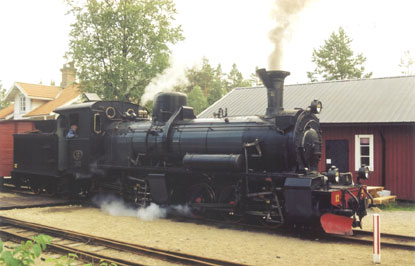
One of the ungue engines in Sweden were the three 0-6-6-0.s of DONJ, of two engines No.8 and No.12 has survied on JTJ.
Here No.12 taking a train with passengers stops in Tallås in summer 2001.
Photos by Ollie Ahokas
Pictures here are taken in July 2002.
Tallås.
Trackplans for the yards

We are entering Tallås, which was the termanial for the preserved line untill a turnout track was constructed 1.5 kilometers further west.

The depot and the combined freighthouse/outhouse. orginally it was considered that Tallås was to be junction to a branch line to north, some 8 km.s to Åmot. The ore producing was declining and the cost for the line proved to be uneconomical. Instead of the branchline, the ore was loaded on horse buggies during the summer and to sleighs during the winter. The trackage today is more modest compared to the past but does feature now a days a turntable.

View from the turntable track to east.

The west end view towrds east. There is no sign of any civilation here, no houses or anything. So the revenues from Tallås must have been minimal.

According most of the litterature claims that the line between Jädraås and Tallås is pretty level. But as you see on this picture at the westernmost turnout towards Pallanite the line actually is a bit of a rollercoaster line.
Pallanite.

Allmost every preserved line has a meeting station some where close the midddle of the run. The lot was actually a sur to a sawmill that provided the line with new ties. The small depot served actually as a flagstop at Stora Björnmossen further west along the line and relocated to Pallanite during the preseved line days.

The Pallanite yard is modest, a pair of turnouts leading some of the crookiest passage tracks I ever seen.

The Pallanite from the opposite end. Note the crookier passage line .

The signals on the line was quite primitive. When the turnout was the turned into the passage track the siganl was turned 90 degrees, shoving the plate towards the on coming train. Gradually these were replaced by semaphores and later on by target signals.